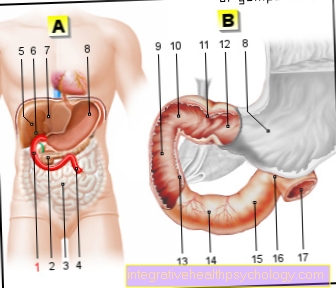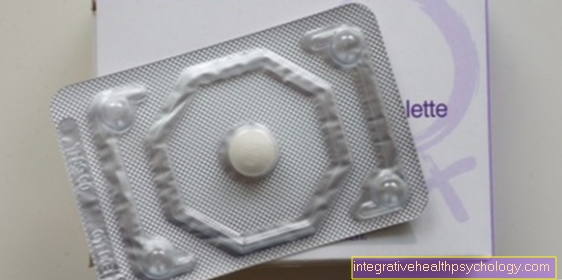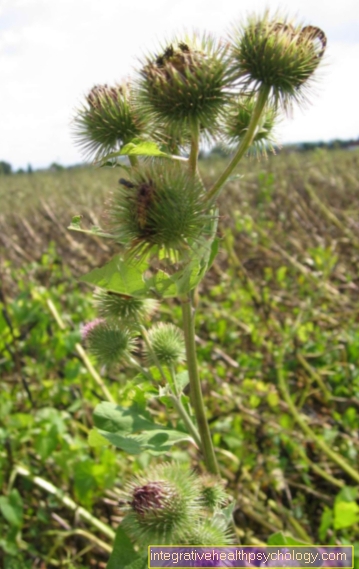Vaginal disorders
Below is an overview and brief explanation of the most important vaginal diseases.
The vagina has a very sensitive vaginal flora that is colonized by naturally occurring germs and fulfills important functions in the defense against pathogens. A change in the vaginal flora can be a cause of vaginal diseases.

Classification
Below you will find the most common diseases of the vagina divided into:
- Infectious diseases of the vagina
- Vaginal cancers
- Inflammation of the vagina
- Other vaginal diseases
Infectious diseases of the vagina
The vaginal infection
A vaginal infection is caused by the entry of various pathogens into the vagina.
This is usually caused by a vaginal flora that is not intact, which makes it easier to enter. The infection can be caused by bacteria, viruses or fungi. The symptoms are often itching or burning in the vagina or when urinating and changes in discharge.
The therapy depends on the causative agent of the vaginal infection. An antibiotic is usually prescribed for bacterial infections, and anti-fungal medication for fungal infections.
You may also be interested in this topic: Itching in the vagina
The vaginal fungus
The yeast Candida albicans and its relatives are among the most common infectious agents that cause inflammation of the vulva and vagina. Scientists estimate that three in four women (75%) will experience a vaginal yeast infection at least once in their life. Five to eight percent of these women have recurrent infections. The vagina is affected more often than the external genital organs. If the external sexual organs are affected, the vagina is almost always also inflamed.
Typical symptoms of candidiasis are itching in the genital area, reddening of the skin, flaky, whitish discharge from the vagina and a burning sensation when urinating and during sexual intercourse. Candida albicans is a small part of the normal bacterial flora of the vagina, but it can gain the upper hand due to hormonal imbalances or the use of antibiotics and then cause the symptoms. The fungal infection is diagnosed through typical symptoms and a microscopy of the discharge. Candidiasis is treated locally using a fungus in the form of vaginal suppositories or ointments. Oral therapy in the form of tablets is only necessary in the case of frequent infections. A fungal infection in pregnancy should be treated even if there are no symptoms. Otherwise there is a risk that the fungi can be transmitted to the child and cause sepsis (colloquially blood poisoning) in the newborn.
You can find detailed information on this topic at: Vaginal fungus
Bacterial vaginosis / amine vaginosis
Amine vaginosis is also known as bacterial vaginosis. It is responsible for about two thirds of the vaginal diseases, the symptom of which is increased discharge. In this disease, the vaginal flora is significantly disturbed, which is triggered by the bacterium Gardnerella vaginalis and various intestinal bacteria. Risk factors for such an infection are having more frequent sex with different partners or taking antibiotics. The discharge is usually white, thin and contains bubbles. There is also a fishy odor caused by the amines produced by the bacteria. Amine vaginosis actually only describes colonization with these bacteria, which can result in vaginal inflammation (colpitis).
In addition to the typical smell, the doctors determine the pH value of the discharge and look for so-called key cells under the microscope. The therapy consists of various treatments: oral antibiotics and vaginal ointment as well as acidification of the vaginal flora with lactic acid and lactobacilli (which are a normal part of the vaginal flora). During pregnancy, the treatment is carried out according to the age of pregnancy. If no therapy is given, there is a risk that the infection can rise and spread to the uterus or ovaries.
You can find detailed information on this topic at: Bacterial vaginosis
Genital herpes
About ten to thirty percent of all people worldwide are infected with the herpes simplex virus type 2, which is mainly responsible for genital herpes. However, the disease does not have to break out in all infected people. Genital herpes is a very painful inflammation of the vulva caused by herpes viruses and transmitted through sexual contact.
Typical symptoms are a classic rash: redness, small nodules with vesicles and open areas that cause a severe burning sensation and pain. The inguinal lymph nodes are very often swollen on both sides. Treatment is carried out with pain killers and the antiviral drug acyclovir for 5 days.
You can find detailed information on the subject at: Genital herpes
Condylomatosis
About 1% of all women have condylomas in the area of the external genitals caused by human papilloma viruses. Condylomas are small, benign growths on the top layer of the skin and are mainly caused by the harmless HPV types 6 and 11. They often go away on their own after a while, but otherwise they can be treated by various methods.
You can find detailed information on the subject here: Human papillomavirus
Trichomoniasis
This sexually transmitted disease is caused by the pathogen Trichomonas vaginalis and is one of the most common sexually transmitted diseases worldwide, with around 200 million diseases annually. In Germany, this disease is rather rare with a frequency of around 1%. With this disease, a yellowish, possibly greenish, foamy discharge occurs. The vagina is slightly red and stinging. The treatment is carried out with a single dose of 2g metronidazole for the affected woman and her partner.
Toxic shock syndrome
Toxic shock syndrome is similar to blood poisoning (sepsis) and can lead to the development of a shock.
It is caused by harmful substances (Toxins) of the bacterium Staphylococcus aureus. A distinction is made between the menstrual form and the non-menstrual form.
- In the menstrual form, i.e. during a woman's menstrual period, the bacteria can accumulate in tampons and develop the toxin. This form has been in decline since the improvement of tampons. Instead, the non-menstrual form increases.
- Risk factors for the non-menstrual form are the use of mechanical contraceptives or childbirth.
Symptoms of Toxic Shock Syndrome are:
- high fever over 38.9 degrees Celsius
- a typical rash
- an increased heart rate
- and decreased systolic blood pressure.
If three other organ systems are also damaged, a diagnosis of toxic shock syndrome can be made. Therapy should always take place in the hospital under intensive medical supervision. As a general measure, you give fluids and try to remedy the cause of the infection. If the toxic shock syndrome is actually triggered by the bacterium Staphylococcus aureus, antibiotic therapy is started according to a specified schedule.
You can find a detailed report on Toxic Shock Syndrome here
Vaginal cancers
Vaginal cancer
Vaginal cancer (Vaginal cancer) is a rare disease. It affects older women and the tumor is often located in the top and back third of the vagina. From there it grows towards the surrounding structures and affects other organs such as the urinary bladder or the rectum at an early stage. Infection with the HP virus is considered a risk factor for the development of vaginal cancer (Human papillomaviruses), which is also associated with the development of cervical cancer.
Symptoms that show up with vaginal cancer include:
- vaginal bleeding
- Ulcers and bleeding on contact
When choosing therapy, it depends on whether the vagina should be preserved, for example if you still want to have children, and where the tumor is located. If you want to keep the vagina, radiation therapy is carried out. Many of the vaginal cancers respond well to radiation. If it is decided that the vagina should be removed, the uterus or the external genital organs must also be removed, depending on the location of the tumor. If other organs are already affected by the tumor, these will also be removed.
You can find detailed information on this topic at: Vaginal cancer
Vulvar cancer
Cancer of the vulva is diagnosed in around 8 out of 100,000 women each year. This makes it the fourth most common gynecological cancer. Typical symptoms are long-term itching and burning, as well as dry vaginal mucosa. In addition, there are visible changes in the skin of the labia and pubic mons, e.g. open spots or indurations.
The most common cause is infection with HPV (human papillomavirus), some strains of which can cause cancer. The best possible therapy is an operation in which the affected tissue is removed with a safety margin of 1 cm. Radiation or chemotherapy only achieve significantly lower healing rates. Since cancer of the vulva recurs in more than 50% of the cases, a close and long follow-up check is very important. If cancer of the vulva is discovered before the lymph nodes are affected, the 5-year survival rate is 80%, with lymph node involvement and larger tumors it drops to 20-60%, depending on the stage.
Inflammation of the vagina
Colpitis
Colpitis is an infection of the vagina.
This can have various causes such as a bacterial load or hormonal causes in the context of menopause. The main symptom of colpitis is altered vaginal discharge. If infected, the vagina may also burn or itch. Antibiotics or anti-fungal drugs are used for therapy. Lactic acid bacteria are also used to rebuild the natural vaginal flora.
Senile colpitis is acute vaginal inflammation after menopause.
Find out more at:
Senile colpitis - what you can do about it
Folliculitis
Folliculitis is the medical term for inflammation of the hair follicle, which is mostly caused by the bacterium Staphylococcus aureus. The hair follicle of a pubic hair or several pubic hairs is inflamed, reddened and painful. It is possible that the hair follicles become inflamed, abscesses large or small. Depending on the extent of the inflammation, local therapy with iodine ointment, antibiotic therapy or a splitting of the abscess under local anesthesia is necessary. Anyone who suffers from frequent inflammation of the hair follicles can counteract this by wearing loose clothing.
You can find detailed information on the subject here: Folliculitis
Bartholinitis
This clinical picture describes an inflammation or congestion of the Bartholin gland. This gland is used to moisten the vaginal vestibule and is located at the vaginal entrance. Inflammation is usually caused by germs in the intestinal flora. The treatment is carried out by surgical opening of the gland, known in technical terms as "marsupialization".
You can find detailed information on the subject here: Bartholinitis
Other vaginal diseases
The vaginal dryness
Vaginal dryness is a common symptom that comes from the vagina not producing enough secretions.
This often accompanies the following:
- Painful intercourse
- an itching or burning sensation of the vagina and
- vaginal infections
The causes of vaginal dryness are mostly hormonal changes, for example during menopause or pregnancy. However, vaginal dryness can also occur as an accompanying symptom in various other diseases. On the one hand, hormone preparations are used for therapy. Alternatively, there are also hormone-free drugs that can help alleviate the symptoms. It should also be ensured that there is no excessive intimate hygiene.
You can find detailed information on this topic at: Vaginal dryness or insufficient vaginal moistening (lubrication) - therapy and prognosis
Vaginal fistula
A fistula describes an unnatural connection between two organ structures.
A vaginal fistula is typically a duct that connects the vagina and the rectum, bladder, or ureter. Causes for the formation of such connecting passages are:
- Tumors
- Surgery, (such as removal of the uterus) or
- Injuries during childbirth
The symptoms of vaginal fistula depend on its location. In the connection ducts between the vagina and the urinary bladder or the ureter, one often sees recurring bladder infections as a symptom. If there is a connection between the rectum and the vagina, inflammation of the vaginal mucous membrane becomes apparent, as constituents of the stool get into the vagina and the germs it contains trigger an infection. The treatment of choice for a vaginal fistula is closure by means of an operation.
Vaginal sagging
The vagina and the uterus are attached to the pelvis by a holding device made up of muscles and ligaments
If this holding apparatus is overstretched or damaged during the birth process, for example, it can, following the force of gravity and with the appropriate disposition, lead to the vagina lowering.
Since both the urinary bladder and the rectum are in the immediate vicinity of the vagina, there may be malfunctions in urination and defecation. In some cases, the bladder and ureter may also sag. The symptoms can be easily deduced. It can lead to bladder emptying disorders or urine and fecal incontinence. In addition, the sagging of the vagina can cause discomfort during sexual intercourse.
The sagging of the vagina can be diagnosed with an ultrasound scan. In more complicated cases, an MRI can provide information about the exact position in the pelvis. In the case of mild progress, training the pelvic floor and administering the hormone estrogen locally can limit the progressive reduction. If the disease is more advanced, especially if the bladder and rectum are already affected, surgical correction can be considered.
Hymenal / vaginal atresia
In hymenal atresia, the hymen closes (Hymen) the complete vaginal entrance.
In vaginal atresia, the vaginal outlet, i.e. the outer opening of the vagina, is missing. Vaginal atresia can either be congenital or caused by injury or infection.
These two malformations often go unnoticed until puberty. With the first menstrual period, the blood collects in the vagina because it cannot flow out. As the blood volume increases, it continues to build up into the uterus and fallopian tubes.
Patients experience monthly pain that increases every month. This can be explained by the increasing amount of blood that builds up in the vagina and uterus. In some cases this can also be felt in the lower abdomen. Another symptom is the lack of menstrual bleeding. The therapy of hymenal atresia consists in widening the hymen with an incision. For vaginal atresia, therapy depends on how extensive the adhesions are. In some cases, one incision is enough to reopen the vaginal outlet. However, it may also be possible that the vaginal outlet has to be completely re-created using plastic surgery.
Swelling in the vaginal entrance
Swelling in the vaginal entrance can be caused by various causes, most of which are harmless.
A common cause is inflammation of the Bartholin's glands (Bartholinitis) on the labia majora. Another cause can be genital warts, which are triggered by the HP virus. The symptoms can also include pain or overheating of the affected area. Therapy for bartholinitis consists of splitting the abscess. Genital warts are removed with the help of laser or cold therapy.
Read more on this topic at: Swelling in the vaginal entrance
The vaginal spasm
The vaginal spasm (Vaginismus) describes an involuntary cramping of the pelvic floor muscles and parts of the vaginal muscles, so that inserting objects into the vagina is only possible with pain, if at all.
This means that there are difficulties during intercourse, inserting a tampon and also during gynecological examinations, although the woman does not oppose it. The cause is usually a malfunction of an organic structure, but it can also be psychological.
The therapy is primarily focused on physical training. With the training of the pelvic floor muscles, the woman learns to tense the muscles at will, but also to relax them. So-called vaginal dilators are also used. These are cone-shaped rods that are supposed to help stretch and loosen the vaginal muscles. Psychotherapy can also be used, but is usually not the therapy of first choice.
You can find detailed information on this topic at: Vaginal cramp





























